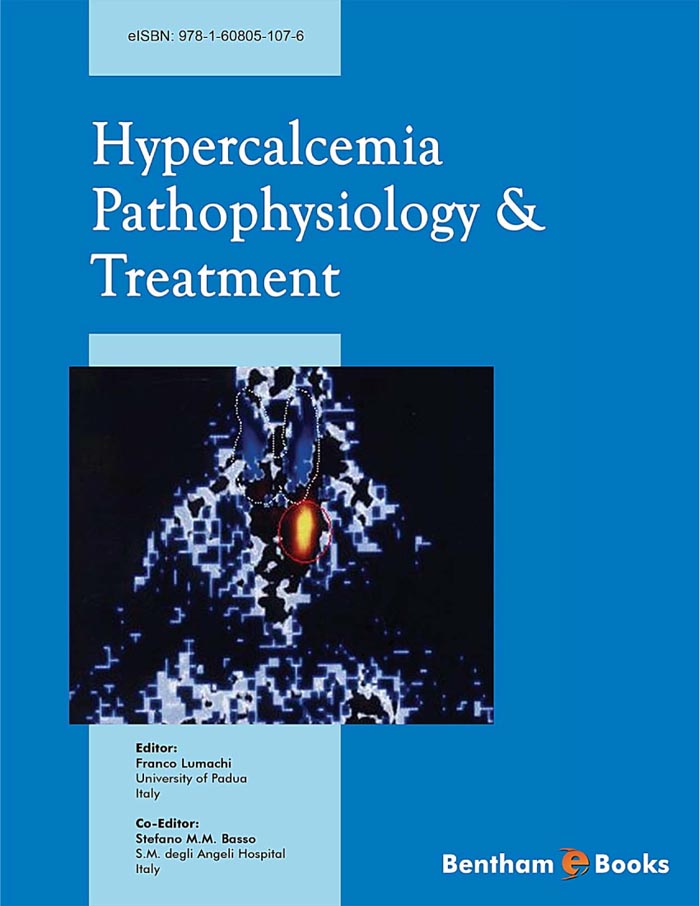Changes in serum calcium concentration regulate several fundamental cellular events, including enzy-matic activities, and cell membranes excitability. In adults 99% of calcium is found in the skeleton, in which it plays both structural and regulatory roles. High blood calcium levels (hypercalcemia) is extremely rare under physiological conditions. It usually occurs when parathyroid hormone (PTH) and 1,25 (OH)2 vitamin D act on osteocytic osteolysis and osteoclastic resorption, transferring calcium to the extracellular compartment. Basic mechanisms regulating calcium metabolism have long been defined, but the complete role of new factors, such as fibroblast growth factor-23 (FGF-23), transient receptor potential cation channel, subfamily V member 5 (TRPV5), and the Klotho gene, is still under study. The main causes of hypercalcemia are primary hyperparathyroidism (HPT), and malignancy-associated hypercalcemia (MAH). Severe or prolonged hypercalcemia may cause several complications, mainly depending on serum calcium concentrations. In any case, the clinical features are usually aspecific, such as muscle weakness, fatigability, asthenia, as well as signs and symptoms of dehydration. Other less common causes of hypercalcemia include increased intake of calcium and vitamin D, granulomatous diseases, other endocrine disorders, multiple endocrine neoplasia, familial benign hypocalciuric hypocalcemia, and other rare disorders.
The therapy of choice for HPT is the surgical ablation of the hyperfunctioning parathyroid tissue, and the best time to cure a patient is during the initial phase. In patients with primary HPT, parathyroidectomy produces a sudden modification of the endocrine balance which regulates the calcium and phosphate metabolism. Currently, minimally invasive parathyroidectomy is widely performed, both videoassisted and radioguided. Physiologically, PTH acts directly on the renal and bone cells, and indirectly it influences the intestinal absorption of calcium, stimulating the renal synthesis of [1,25(OH)2]D3. Although there is an immediate renal response to serum PTH levels, The modifications which take place in the bone are slower, according to the particular way of the bone-remodeling process. The antireabsorptive action of bisphopshonates has been considered the most effective in the disorders characterized by an excessive bone resorption. Unfortunately, patients with MAH have usually advanced tumors which explains short survival rate. However, when the first diag-nosis is a chemosensitive tumor, such as multiple myeloma or metastatic breast cancer, long-term remissions may be obtained. Calicimimetic drugs and humanized monoclonal antibody against human parathyroid hormone-related protein represent the new drugs useful to treat hypercalcemia.
Serum calcium has a pivotal role in the homeostasis of an organism, and its alteration has important effects. Knowledge of role and regulatory mechanisms of serum calcium is crucial to understand and diagnose the underlying diseases, that cause hypercalcemia. This book is a compilation of the efforts of a selected group of well-established experts in the field of calcium metabolism, and management of the causes of hypercalcemia. It summarizes the principle findings and points out possible pitfalls in hypercalcemic diseases, with the aim to help both students in the understanding and clinicians in their approach to patients with hypercalcemia.
We would like to thank Director Mahmood Alam and particularly Assistant Manager Asma Ahmed, together with the whole Bentham Science Publishers, for their effort and support.
Franco Lumachi, M.D.
Associate Professor of Surgery
University of Padua, School of Medicine
35128 Padova, Italy
Stefano M.M. Basso, M.D., Ph.D.
Assistant Professor
S. Maria degli Angeli Hospital
33170 Pordenone, Italy

